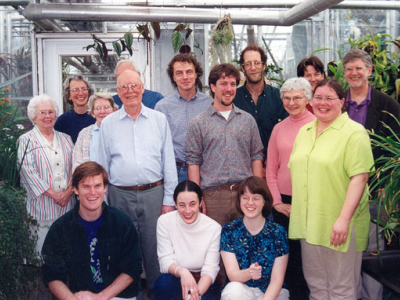Bryology at Duke was initiated by the late Professor H. L. Blomquist, who came to Duke (then Trinity College) in 1921. Professor Blomquist received his Ph.D. degree from the University of Chicago. His dissertation work involved developmental studies on the fern, Dicksonia, under the supervision of W.J.G. Land, the noted morphologist. While at Chicago, Blomquist came under the influence of its strong morphology tradition. His teachers included the notable botanists Coulter, Chamberlain, Cowles, and the young physiologist, Charles R. Barnes. Barnes published the first keys to the mosses of North America, based on the Lesquereux and James manual. There was no taxonomy at Chicago in those days, and Blomquist had no formal taxonomic training. He came to Duke as a morphologist. He had a fundamental knowledge of bryophyte morphology, however, and introduced a course called Morphology of Bryophytes and Ferns. Blomquist had little knowledge of bryophytes in the field and was fascinated to find mosses and hepatics that he has seen only in preservatives and slides. He therefore began to collect. He had no concept of an herbarium and no experience in collecting and preparing specimens. He joined the Sullivant Moss Society (now the American Bryological and Lichenological Society) and soon began correspondence with George Conklin, George B. Kaiser, A.J. Grout, A.L. Andrews, and Alexander W. Evans, all of whom identified specimens for him and provided information on how to prepare and packet specimens. Thus, the early 1920’s saw the beginning of the bryophyte herbarium at Duke; a shoebox of mosses casually placed on a shelf.
Blomquist was a generalist. He was interested in all groups of plants. His shift from morphology to taxonomy occurred when he met an amateur botanist and plant collector from Winston-Salem, North Carolina, P.O. Schallert. Schallert was a physician by profession, but collected all groups of plants. He was an avid collector with a good eye for the unusual, but he was a bad influence for an impressionable Blomquist. Schallert, who collected in huge quantities and whose specimens are distributed all over the world, was careless in his collecting and processing habits. Consequently, the locality data for Schallert’s own collections are not always trustworthy. His mis-labeled specimens have produced some odd distributional anomalies.
In 1930, Schallert sold his entire herbarium, consisting of 16,000 specimens, to Duke University. About 4000 of these were bryophytes, lichens, and algae. There is not an exact inventory of the number of bryophytes, but we estimate about 3,000. Schallert exchanged widely, and many of these exchanged specimens are excellent: reliably labeled and accurately determined. Schallert’s herbarium and Blomquist’s early collections thus formed a small nucleus around which the Duke herbarium grew and diversified.
Professor Henry J. Oosting joined the Department of Botany at Duke in 1932 as a plant ecologist and began a research program in vegetation analysis. Desperately needing a working herbarium for his vascular plant studies, he volunteered to serve as curator of the entire collection. Oosting had excellent training in systematics, first at Michigan State University, under Darlington, and with Rosendahl and Butters at the University of Minnesota, where he studied ecology with Cooper. It was Oosting’s interests and energies that organized and guided the Duke herbarium into a working facility. All the Schallert bryophytes were repacketed and mounted on sheets, with the packets geographically segregated.
In 1936, Lewis E. Anderson was added to the Botany faculty to teach and develop a research program in cytology. Earlier, Anderson had developed a side interest in mosses during a portion of a summer in the Ozarkian Highlands of Arkansas. This interest was heightened when he took Blomquist’s course on mosses and ferns as a Master’s Candidate at Duke in 1931, and during two summers that he spent with Blomquist in the Southern Appalachian Mountains. Anderson was given the responsibility of curating the moss herbarium. He retained these duties until he retired in 1982. Gradually, Anderson’s research interests shifted from cytology of cell organelles to the systematics, ecology, and cytogenetics of mosses. The culmination of his interests in the moss flora of Eastern North America was his monumental, two-volume flora, published in 1981 (in collaboration with Howard Crum; see Crum, H.A. & L.E. Anderson, Mosses of Eastern North America, Columbia University Press, New York, 1981). A considerable amount of Anderson’s energies went into the expansion and development of the bryophyte herbarium, disproportionately concentrated on mosses, and to the acquisition of a bryophyte herbarium. Eventually, a graduate program in bryology was established and a course in bryology was offered, emphasizing field studies (a tradition that continues today).
Anderson’s successor, Brent D. Mishler, arrived at Duke in 1984. Mishler occupied the position of Assistant, then Associate Professor of Botany, and Curator of the bryophyte herbarium, until he left for the University of California at Berkeley in 1993. Mishler is now Professor and Director of the University and Jepson Herbaria at Berkeley. During his stay at Duke, Mishler was active in phylogenetic studies on bryophytes, development of systematic theory, and taxonomy of the moss genus, Tortula. While at Duke, Mishler gathered information about the history of bryology at Duke from which the summary provided above was derived.
Jonathan Shaw joined Duke’s Botany Department as Associate Professor and Curator of Bryophytes in 1996. Shaw’s research interests include the reproductive biology and population genetics of mosses, phylogenetic studies utilizing nuclear, chloroplast and mitochondrial DNA, and the application of DNA sequence data to evolutionary questions at and below the species-level. Shaw gave his bryophyte herbarium, especially rich in collections of the Bryaceae, to Duke when he came in 1996. He has a strong commitment to collections-based research.
